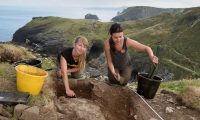 A team from the Cornwall Archaeological Unit (CAU) have discovered a stone engraved with an extremely rare example of writing from the 7th century at Tintagel Castle in Cornwall. It’s not a formal inscription; it was carved by someone doodling or practicing on a window ledge at the castle.
A team from the Cornwall Archaeological Unit (CAU) have discovered a stone engraved with an extremely rare example of writing from the 7th century at Tintagel Castle in Cornwall. It’s not a formal inscription; it was carved by someone doodling or practicing on a window ledge at the castle.
The slate ledge was found under the ruins of the 13th century castle built by Richard, Earl of Cornwall, brother of King Henry III, in an excavation that is part of five-year archaeological survey and excavation commissioned by English Heritage. Digs began in 2016, and archaeologists quickly found the remains of massive stone walls. Fragments of pottery and glass imported from Merovingian France, what is today western Turkey, North Africa, the Aegean are evidence of a thriving trade in luxury products between Tintagel and the Mediterranean from the 5th century until the decline and abandonment of the site in the 7th century.
When the stone was discovered, its importance was immediately evident. It wasn’t until the stone was cleaned that archaeologists saw the wording and realized they had found something of major significance.
The ledge includes what is believed to be a Roman name, Tito, and a Celtic one, Budic. The Latin words fili (son or sons) and viri duo (two men) also appear.
Another intriguing element is a letter “A” with a “V” inside it and a line across the top. The “A” may refer to alpha, which is associated with God. One tail of the symbol morphs into a miniature “A”, which may link back to the word fili. A triangle carved into the slate may be the Greek letter delta. […]
Prof Michelle Brown, an expert in medieval manuscripts at the University of London, was given the task of deciphering the inscription. She said: “The survival of writing from this period is rare and this is a very important find. The text features a mix of Latin script with some Greek letters, and a distinctive monogram [the shape based on the letter “A”]. It suggests a high level of literacy and an awareness of contemporary writing styles associated with the early illuminated manuscripts of Britain and Ireland.
“Other examples of writing in Cornwall and western Britain at this period take the form of monumental inscriptions on stones, but this example is quite different, with a writing style and layout suggestive of a competent scribe from a Christian background, who was familiar with writing documents and books and who was practising a series of words and phrases rather than carving a finished inscription.”
Researchers will continue to study the slate. X-ray fluorescence (XRF) analysis has not found the remains of any polychrome paint, but archaeologists are hoping high resolution scanning will shed more light on the scribe, whether he was left or right-handed, and on the inscription itself, like what tool was used to carve it. The stone has gone on display at Tintagel Castle as of this Saturday, June 16th.
A shopping list? – What I read, is “ICITO”, “Z”, “FILI”, and in the middle thereof, what might be in Greek, Latin or Arab “UTHERPENDRAGON”, “ARTHUR” or “BUDIC”. Where does it say “VIRI DUO”? ..OK –with a little fantasy– the “Arthur” might be indeed “VIRI BUO”.
Moreover, the “Z” might also be an “A”, possibly indeed with a “V” -or- in lower case a “B”, and could it be that the photographer was “practicing” as well? Are parts missing”? Why exactly is there no additional picture in plan view (i.e. with lighting from aside)?
:hattip:
Me again – What about:
“(d)icito viri duo A fil i” ?
..No idea, where ‘Budic’ comes into play, though :confused:
—————
Carolingian minuscule, for example, was created partly -and I dare say, seemingly for a reason- under the patronage of the Emperor Charlemagne so that the alphabet could be easily recognized by the literate from one region to another.
Charlemagne, however, must have had a keen interest in learning, as according to his biographer Einhard:
“Temptabat et scribere tabulasque et codicellos ad hoc in lecto sub cervicalibus circumferre solebat, ut, cum vacuum tempus esset, manum litteris effigiendis adsuesceret, sed parum successit labor praeposterus ac sero inchoatus.”
“He also tried to write, and used to keep tablets and blanks in bed under his pillow, that at leisure hours he might accustom his hand to form the letters; however, as he did not begin his efforts in due season, but late in life, they met with ill success.” 😆
What does it matter? Arthur was from Kelso.
By the way, calamity! The Glasgow School of Art has had another fire and this one may have destroyed everything beyond any hopes of salvage. It reminds me what a tiny part of ancient life is represented by archaeological finds. Most stuff, good or bad, perished long ago.
Yeah, it’s indeed all volatile, Dearie. And you may have a point with ‘Kelso’.
Is there information on Iron Age and Early Medieval cattle herding and driving available, e.g. to and fro the pastures? In the bottom left hand corner on that photo, there might be what could be “bɣdic”. The term could be interpreted as ‘cattle judge’ (βοῦς) or the one in charge of the trail. Maybe, two locals from Tintagel joined the trail to Glasgow with their cattle, who knows? 😉
———
As I always say: Never underestimate a cattle herder’s “level of literacy and awareness of contemporary writing styles, associated with illuminated manuscripts”!
What a view at that dig. Just… watch your step!